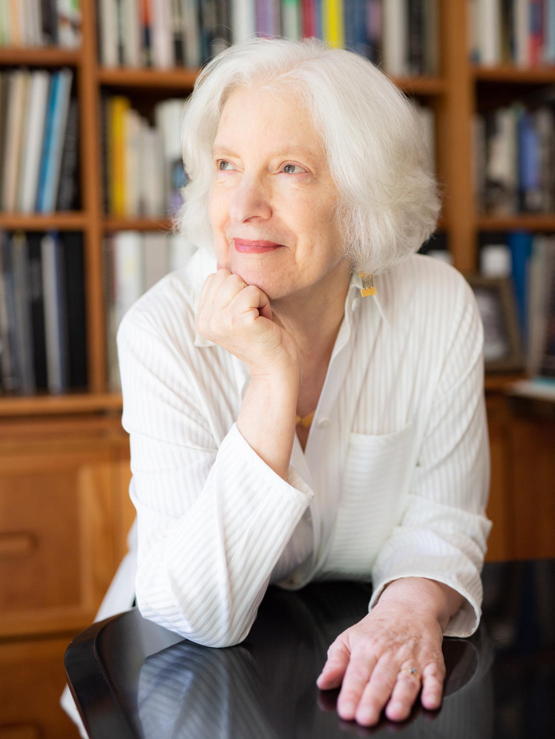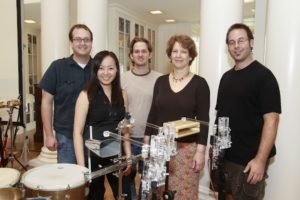
Composer Judith Shatin is renowned for her richly imagined music that seamlessly spans acoustic and digital realms. Called “highly inventive on every level” by The Washington Post, her music combines an adventurous approach to timbre with dynamic narrative design and a keen awareness of the sonic landscape of modern life. She draws on multiple fascinations with the sounding world (both natural and built), literature, the visual arts, and music’s social and communicative power to craft a musical language that resonates with performers and audiences worldwide.
Vividly orchestrated and bursting with imaginative detail, the piece grabs a listener’s attention right from the opening moment…” –The San Francisco Chronicle
Shatin’s extensive catalog includes chamber, choral and orchestral music, and electronic, electroacoustic, and multimedia pieces. Her music has been commissioned by organizations such as the Barlow Endowment, the Fromm Foundation, Carnegie Hall, and The Library of Congress, and by acclaimed ensembles including Kronos Quartet, Da Capo Chamber Players, Ensemble Berlin PianoPercussion, Hexagon Ensemble, the San Francisco Girls Chorus, and the Young People’s Chorus of NYC. The American Composer’s Orchestra and the Charlottesville, Denver, Houston, Illinois, Knoxville, Minnesota, and National Symphonies, among many others, have programmed and commissioned her works. Her compositions are performed in concert halls around the world such as Carnegie Hall, The Concertgebouw, The Kennedy Center, Konzerthaus Berlin, and Tel Aviv Opera house; and featured at festivals including Aspen, BAM Next Wave, Grand Teton, Moscow Autumn, Seal Bay, Spring in Havana, and West Cork.
Recent commissions include Kassia for clarinet, harp, and string quintet, for the Kassia Ensemble; Terra Infirma for amplified septet and electronics for Michigan Technological University; and Of Wells and Springs for alto sax and percussion for the Bent Frequency Duo. Choral commissions include The Gift to Sing, for Charlottesville-based Zephyrus and How is Your Heart Today, for the Atlanta Young Singers.
“There’s no sense of detached, solipsistic, intellectual enterprise in this work, which dazzles with its array of active sound surfaces and shapes… –San Francisco Herald
Electronic media is a key element of Shatin’s creative process; interactive electronics, pre-composed audio playback, computer-generated sound, and processed field recordings appear in compositions of every genre. Her work Penelope’s Song for solo instrument and electronic playback, now available for six different solo instruments, has received hundreds of performances and has been commercially recorded by an array of acclaimed musicians, including flutist Lindsay Goodman. Ice Becomes Water for string orchestra and electronics, incorporating sonic elements fashioned from glacier field recordings, and For the Birds, for amplified cello and processed birdsong, highlight the impact of the disappearing natural world on our challenged ecosystems.
Another primary creative focus for Shatin is the setting of texts drawn from a broad range of sources, ranging from texts by poets Barbara Goldberg, Gertrude Stein, and Avrom Sutzkever, to Biblical ones, such as Adonai Ro’i (Psalm 23), to La Frontera, an anonymous poem by an undocumented immigrant youth held in an American maximum-security detention center. Her folk oratorio COAL, an evening-length work for chorus, Appalachian ensemble, synthesizer, and electronic playback, features a libretto by the composer. COAL was sponsored by the Lila Wallace Readers Digest Arts Partners Program as part of a two-year retrospective of Shatin’s music at Shepherd College in West Virginia.
“The term ‘folk oratorio’ looks like an oxymoron, yet Judith Shatin’s Coal blends folk and oratorio so skillfully that it not only makes sense, but can be transposed to other places as a prototype, tying regional industry to art.” –Chorus! Volume 7, #5
Shatin’s music has been honored with four National Endowment for the Arts Composer Fellowships and grants from the American Music Center, Meet the Composer and the Virginia Commission for the Arts. She has held fellowships for creative residencies at Bellagio, Brahmshaus, Casa Zia Lina, La Cité Internationale des Arts, MacDowell, Mishkan Omanim, the Virginia Center for Creative Arts, and Yaddo.
“There is a refreshing trend in new music to create work that is theatrical, even visceral, without resorting to clichés or purely programmatic devices. American composer Judith Shatin falls into this category for me” –Fanfare
Shatin’s music is published by C.F. Peters, Colla Voce, E.C. Schirmer, Hal Leonard and Wendigo Music. Her music is featured on albums on the Centaur, Innova, Navona, Neuma, New World Records, Ravello, and Sonora labels.
In demand as a master teacher, Shatin has served as a senior composer at the Wellesley Composers Conference and the Chamber Music Conference of the East, as a Master Artist at the Atlantic Center for the Arts, Senior Composition Faculty at California Summer Music, and guest composer at the Aspen Music Festival. Shatin is also a powerful advocate for her fellow composers. She served as President of American Composers (1989-93), has been a Board member of the League/ISCM in New York, of the American Composers Alliance and currently serves on the Board of the National Council of the Atlantic Center for the Arts. She has served on the Executive Committee and as a member of the Fellows Council of the Virginia Center for Creative Arts and is on the Advisory Board of the International Alliance for Women in Music.
Shatin holds degrees from Douglass College (BA, Phi Beta Kappa, Julia Carlie Prize in Composition), The Juilliard School (MM., Abraham Ellstein Award), and Princeton University (MFA, Ph.D.). She is William R. Kenan Jr. Professor Emerita at the University of Virginia, where she founded the Virginia Center for Computer Music.
Composer Judith Shatin is renowned for her richly imagined music that seamlessly spans acoustic and digital realms. Called “highly inventive on every level” by The Washington Post, her music combines an adventurous approach to timbre with dynamic narrative design and a keen awareness of the sonic landscape of modern life. She draws on multiple fascinations with literature, the visual arts, the sounding world (both natural and human-made), and music’s social and communicative power to craft a clear, direct musical language that resonates with performers and audiences worldwide.
Described as “powerful and distinctive” by Fanfare and “both engaging and splendidly controlled” by the San Francisco Chronicle, Shatin’s music has been commissioned by organizations such as the Barlow Endowment, the Fromm Foundation, Carnegie Hall, and The Library of Congress, and by acclaimed ensembles including Kronos Quartet, Da Capo Chamber Players, Hexagon Ensemble, the San Francisco Girls Chorus, and the Young People’s Chorus of NYC. The American Composer’s Orchestra and the Knoxville, Minnesota, and National Symphonies, among many others, have programmed and commissioned her works. Her compositions are performed in concert halls around the world such as Carnegie Hall, The Concertgebouw, The Kennedy Center, Konzerthaus Berlin, and Tel Aviv Opera house; and featured at festivals including Aspen, BAM Next Wave, Grand Teton, Moscow Autumn, Seal Bay, Spring in Havana, and West Cork.
The recipient of four National Endowment for the Arts Composer Fellowships and grants from the American Music Center, Meet the Composer and the Virginia Commission for the Arts, Shatin also garnered major support from the Lila Wallace Readers Digest Arts Partners Program for the creation of her folk oratorio COAL. She has held fellowships for creative residencies at Bellagio, Brahmshaus, Casa Zia Lina, La Cité Internationale des Arts, MacDowell, Mishkan Omanim, the Virginia Center for Creative Arts, and Yaddo.
Shatin’s music is published by C.F. Peters, Colla Voce, E.C. Schirmer, Hal Leonard and Wendigo Music. Her work appears on over 30 commercial recordings from the Centaur, Innova, Navona, Neuma, New World Records, Ravello, and Sonora labels.
Shatin holds degrees from Douglass College (B.A.), The Juilliard School (M.M.), and Princeton University (MFA, Ph.D.). She is William R. Kenan Jr. Professor Emerita at the University of Virginia, where she founded the Virginia Center for Computer Music.
Composer Judith Shatin is renowned for her richly imagined music that seamlessly spans acoustic and digital realms. Called “highly inventive on every level” by The Washington Post, her music combines an adventurous approach to timbre with dynamic narrative design and a keen awareness of the sonic landscape of modern life. She draws on fascinations with literature, the visual arts, the sounding world, and music’s social and communicative power to craft a clear, direct musical language that resonates with performers and audiences worldwide.
Shatin’s extensive catalog includes chamber, choral and orchestral music, and electronic, electroacoustic, and multimedia pieces. Her compositions are performed in concert halls and at festivals such as Carnegie Hall, The Concertgebouw, The Kennedy Center, Aspen, BAM Next Wave, and Moscow Autumn. She has been commissioned by organizations and acclaimed ensembles including the Barlow Endowment, the Fromm Foundation, Kronos Quartet, Da Capo Chamber Players, and The American Composer’s Orchestra.
Shatin’s musical honors include four National Endowment for the Arts Composer Fellowships and grants from the American Music Center, Meet the Composer, the Virginia Commission for the Arts, and the Lila Wallace Readers Digest Arts Partners Program. She has conducted residencies at Bellagio, La Cité Internationale des Arts, MacDowell, and Yaddo.
Shatin’s music is published by C.F. Peters, Colla Voce, E.C. Schirmer, Hal Leonard, and Wendigo Music, and her work appears on over 30 commercial recordings.
Shatin is currently William R. Kenan Jr. Professor Emerita at the University of Virginia, where she founded the Virginia Center for Computer Music.

Teaching is central to my life as a composer. As Rabbi Hanina, in the Tractate Ta’anit of the Talmud, says, “I have learned much from my teachers, more from my colleagues, most of all from my students.” Close interaction with students, at both the undergraduate and graduate level, has encouraged me to remain engaged, whether in the case of the quickly evolving field of computer music or in developing new courses ranging from The Mind of the Artist (team-taught with art historian David Summers and cognitive psychologist Michael Kubovy), to Songwriting, to Psychology of Music (team-taught with cognitive psychologist Michael Kubovy) to undergraduate music theory and graduate seminars on topics such as Temporality in Post-tonal Music and Parsing the Electroacoustic.
I founded the Virginia Center for Computer Music in 1987-88, to create opportunities for students and faculty in the new area of digital music, to develop new courses, and contribute to new research. I also authored multiple successful grants, totaling more than $100,000, including an Academic Enhancement Award, for which the department received $60,000 over three years to further the program. More information about the VCCM can be found here. I was also a principal designer of the Ph.D. program, inaugurated during my second term as department chair, in Composition and Computer Technologies at UVA. This dynamic program has flourished since its inception. My teaching always combines project-based and theoretical work. I have guided numerous undergraduate and graduate students, and those who have completed the Ph.D. have a wide variety of interests and achievements. Some examples include Juraj Kojs, Peter Traub, Steve Kemper, and Scott Barton, and Yuri Spitsyn, who is doing ground-breaking work in the application of MIR techniques to compositional design. Other graduates’ exciting work ranges from cyber instruments and physical modeling to net-based art, robotics, interactive dance, and electroacoustic music.
While it is critical for students to understand conceptual frameworks and historical context, it is also crucial that they actualize that understanding. How they do so of course depends on the level and nature of the course. In a computer music course, it might involve sonification of a data set, while a project in a counterpoint seminar involved analyzing and then directing a performance of Palestrina’s Sicut Cervus. Songwriting, projects include the collaborative performance of individually-composed songs developed and critiqued in group settings, as well as the development of songs modeled on traditions ranging from the blues to those of current playlists.
Disciplinary changes have also affected my notions of what students both ought and need to know. When I began teaching, music theory was primarily taxonomic or structuralist in its stance. Scientific (some say scientistic) approaches were common. Although these did and do provide useful tools for understanding musical design, they typically ignore cultural context. Cultural Studies, an often welcome corrective, sometimes turns the lens from particular musical artifacts to the cultural work they do; and away from concert music to popular music and spectacle. It is the integration of both cultural context and particular musical embodiment that informs my teaching.
While at UVA, I served two terms as Chair of the McIntire Department of Music, leading the establishment of the first Ph.D. program in music in Virginia, including the Ph.D. in Composition and Computing Technologies. I also established the Free Bridge Quintet and oversaw the continued growth of the entire program. While at UVA, I have been a Senior Fellow in the Commonwealth Center for Literary and Cultural Change, organizing a seminar on Computing and Cultural Change with guests including John Chowning and Max Matthews; and was an Associate Fellow in the Institute for Advanced Technology in the Humanities (IATH), applying new technologies to compositional design. I was also named ‘Teacher of the Year’ by the University’s secret Z Society, and am the first to be promoted to the position of chaired professor in the history of the department.
In demand as a Master Teacher, I have served in that capacity at the Atlantic Center for the Arts, the Bennington Chamber Music Conference, the California Summer Music, the Wellesley Composers Conference, and as BMI Composer-in-Residence at Vanderbilt University. I have lectured widely, ranging from the Leemensituut in Leuven to Haifa University to the Verona Conservatory. For a more complete list, see my CV.
